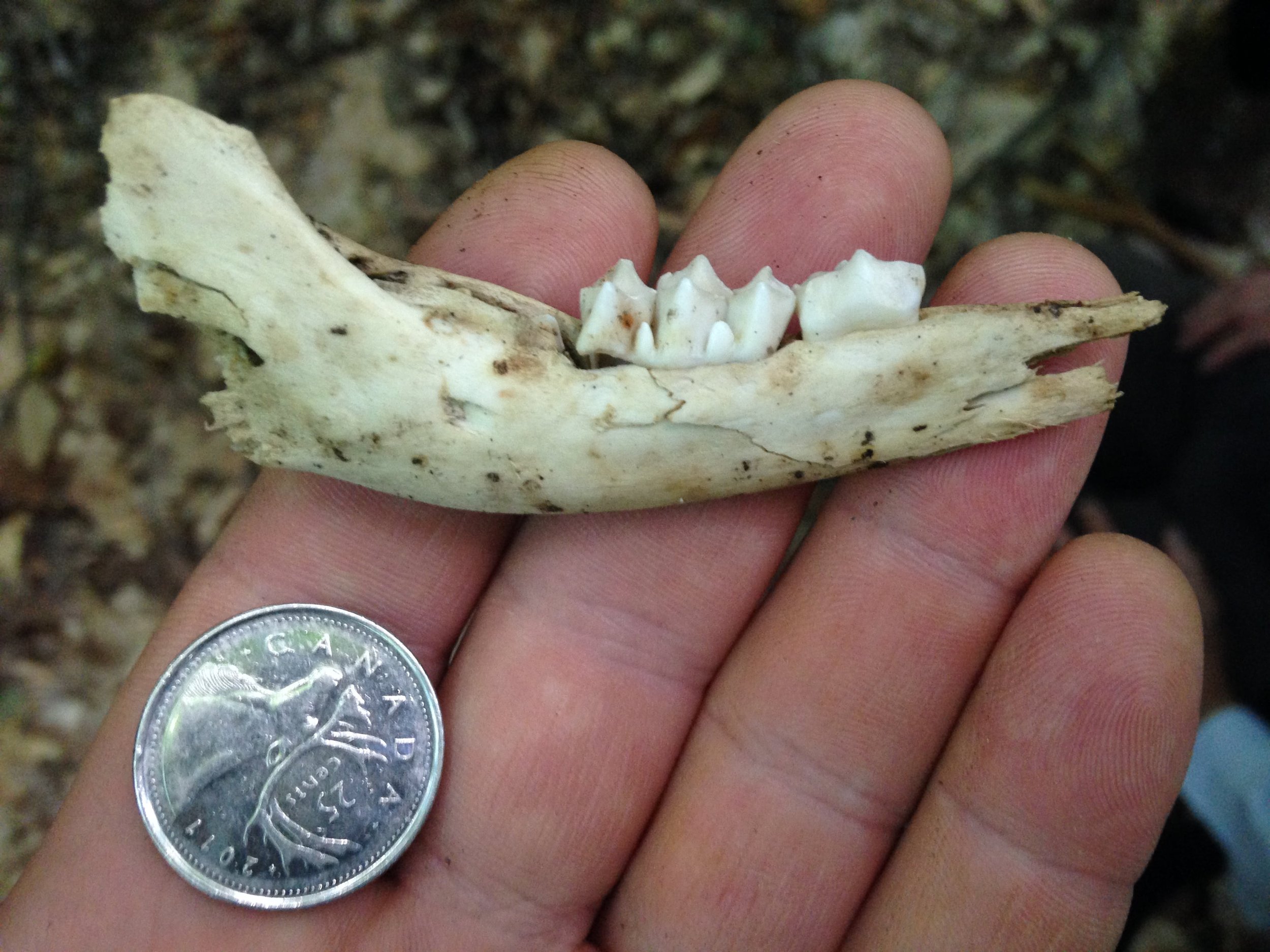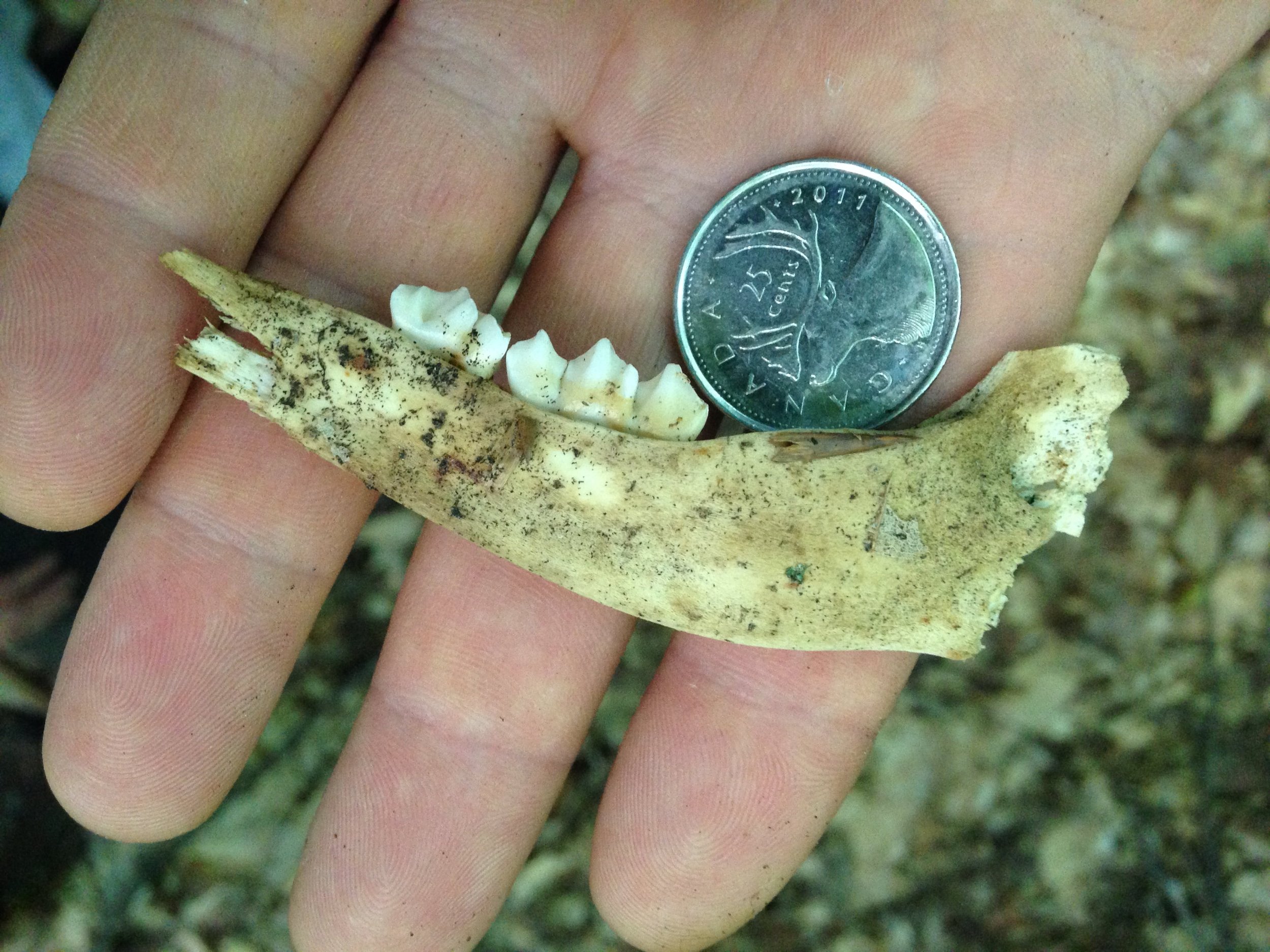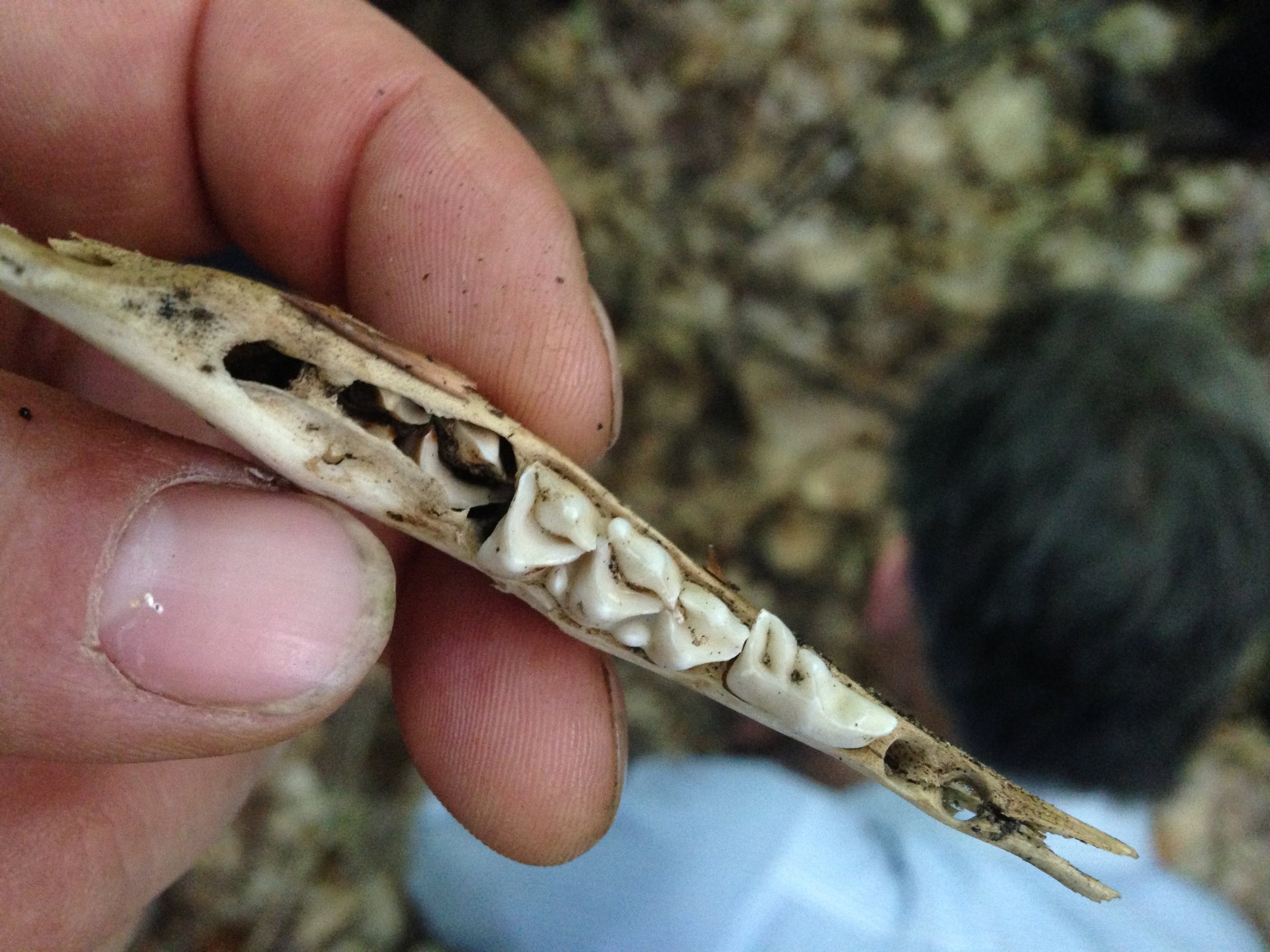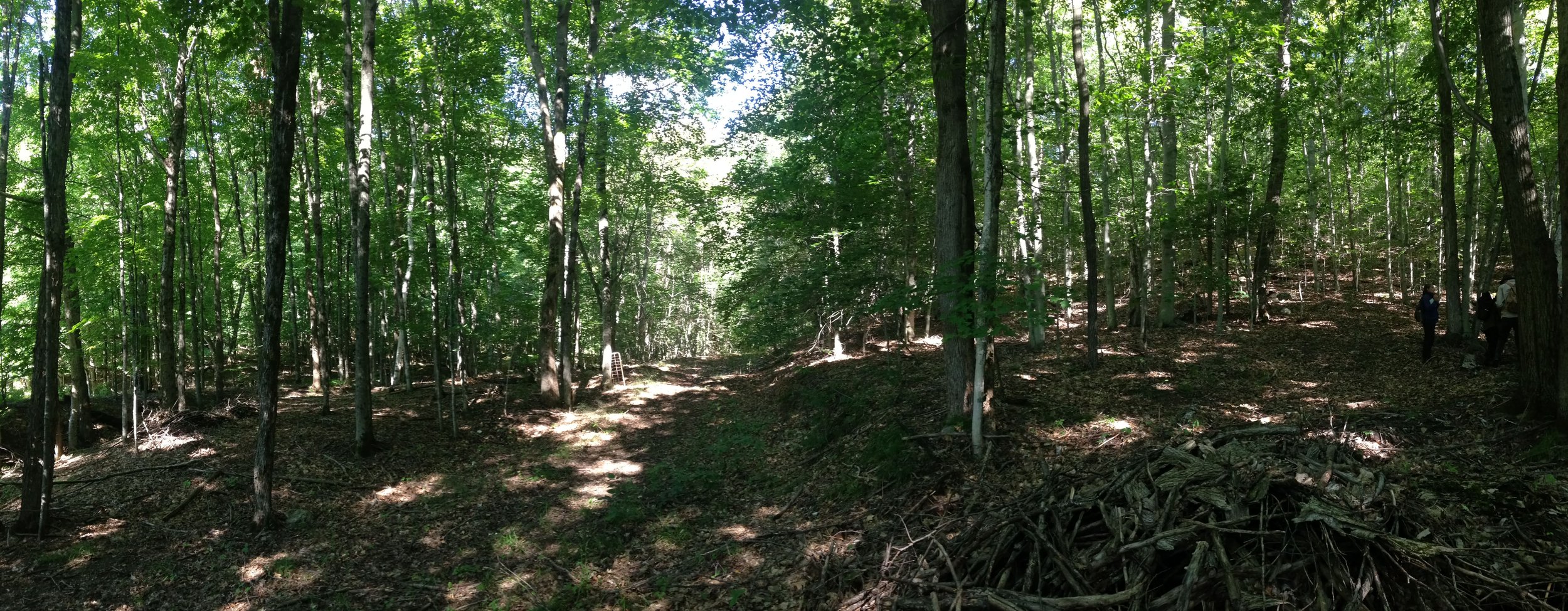A mystery while tracking in Lake of Bays, 2022.08.13
Saturday Aug 13, Conditions at Dwight, Ontario : high of 25*C; low of 7*C; wind coming generally from the North, max wind 7km/h; mix of sun and cloud.
This was the second time I had been into these woods, situated nearly in the middle of Lake of Bays in Central Ontario. The first time I was here, some of us trailed White-tailed Deer (Odocoileus virginianus) feeding sign until we found the Deer. That was back in February, when these hills and valleys were deep in snow. Now we thanked the shade for keeping the hot sun off our shoulders while we looked for signs in the debris.
Debris tracking can really be challenging for me. I get frustrated easily while looking for bent grasses, broken dead leaves, unseen impressions in the mud and soil below the leaf litter. As described in conversation between some other trackers and I, it’s as if we are seeing tracks where there are none, and not seeing tracks where there are, and not being able to tell the difference. There are broken twigs, rocks, Southern red-backed vole (Myodes gapperi) tunnels, hollow bits where roots held up the soil, questionable digs, and tracks from animals who went by days before. The skill set of identifying a fresh trail with certainty in the jumbled quilt of the Summer forest floor is definitely an art and science with which I have little purchase… but I will continue to work at it. With time, patience, good conditions to suit a beginner, I will get better at this skill. I have a couple small debris tracking victories and keeping those in mind will help me stay motivated.
A skill set that I do feel a growing confidence about is bone identification and while making our way up the hill in the leaf little there was a small mandible laying fairly exposed with the lingual surface (the side which would be closest to the tongue in the living animal) facing the canopy.
*Quick note here: Lingual/Buccal are anatomical terms of location often used in reference to the teeth and not the mandible. Through researching for this blog post, I have found other sites and books which use lingual/buccal to describe the orientation of the jawbone as well as the teeth. I find this useful and will use this nomenclature here.




When I quickly looked at the mandible I thought White-tailed Deer, but then I challenged my own thoughts because of the size. The mandible, measured from the furthest points, was 7.6 cm (3 in) long, which is more so the size of a Raccoon (Procyon lotor) mandible. I also have a bit of a rule, when it comes to finding skulls, uncertain tracks or scat: “it’s a Raccoon, until it’s not.” Following this logic I had to test it based on my observations of the mandible we found.
Raccoons and Deer have differently shaped teeth to facilitate different diets; Deer have incisors at the very front of their long narrow mandibles, and then some premolars and molars with high cusps which slowly wear away due to browsing woody branches and twigs in winter and grazing green forbs in the warmer months. Raccoons have thinner pointier teeth in the front of their mouths for cutting, large canines for tearing, and high cusped cheek-teeth to facilitate crushing. Their flatter molars are well suited for grinding up fruit and plant matter at the posterior end of the mandible. From the look of this mandible there were no signs of canines at the anterior end of the mandible, and the bone itself seemed too narrow to be able to support the work that the canines do in crushing and tearing. I had to assume White-tailed Deer, but it was so small that I still wasn’t sure. I had to look at the number of teeth and what kind of shape the teeth were in.
The mandible we found had two teeth still on it, the second and third premolars. The first premolar, which is missing, would be located closest to where the incisors would be, and must have fallen out before we came along. There was another tooth located within the mandible, but it had not yet erupted. By the looks of it, only three teeth had erupted, the three premolars, with the first molar still nestled within the socket. Let’s work our way backwards to try and age this Deer.
A mature White-tailed Deer has 32 teeth. A dental formula is a way of quickly explaining which teeth the animals has, and how many. When writing out the dental formula, i stands for incisors, c are canines, p are premolars, m are molars. The first number in a set is always the teeth in the cranium (top of the mouth), followed by teeth in the mandible (teeth in the jaw). Also, the number given is for only one side of the animals mouth. That means that you must double the number to get the total amount. The dental formula for a mature White-tailed Deer is as follows : i 0/3 c 0/1 p 3/3 m 3/3 = 32. This was certainly not a mature White-tailed Deer.
By the time a Deer is 1½ years old there should be not only an additional two molars, but also the 3rd premolar (circled in red in the fourth image), with its three parts should be replaced by a new 3rd premolar with only two parts. The fact that there are three parts to this 3rd premolar tells me that this Deer is younger than 1½ years old. As for the two molars which should be there, the second molar, or fifth tooth to erupt, should be present by six months after the fawn is born. This is not present. This means the fawn is younger than six months. The first molar, the tooth which is nested in the socket (visible in the image looking down on the tops of the teeth from above) should have erupted by the time the fawn was born. That would mean there should be four teeth when the fawn is born.
So, if four teeth should be present when a fawn was born, and there are only signs that three teeth have erupted on the mandible, could this mean that this mandible is from a Deer that had not been born yet? This was a thought after Alexis told a story of a time he was tracking Wolves (Canis sp.) and they had come across a kill site where, from their interpretations of the tracks and sign, a pregnant Moose (Alces alces) cow had been killed and the calf was torn from her womb and consumed a few meters away. It’s an interesting idea, but I have no way to confirm that this was a calf that had not come to term, but instead I can only look at the tooth replacement as a gauge on how old the Deer was. I will have continue to do more research to get more precise answer, but I can say with relative certainty that this is the mandible from a Deer which not yet come to term up to the age of 4 months.
To learn more:
White-tailed Deer Jawbone Aging: Part 1 -- Tooth Replacement
Human and Non-human Bone Identification by Diane L. France (CRC Press, 2009)
The Deer of North America by Leonard Lee Rue (The Lyons Press, 1997)
Animal Skulls by Mark Elbroch (Stackpole Books, 2006)
A Key for Aging White-tailed Deer Using the Tooth Replacement and Wear Technique
Aging a Deer by Examining Its Jawbone

